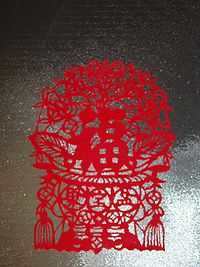Chinese paper cutting

Chinese Paper Cutting or Jianzhi (剪纸) is the first type of papercutting design, since paper was invented by Cai Lun in the Eastern Han Dynasty in China. The art form later spread to other parts of the world with different regions adopting their own cultural styles. Because the cut outs are also used to decorate doors and windows, they are sometimes referred to "chuāng huā" (窗花), meaning Window Flower.
Symmetry

There are basic cut outs, that are a single image. And there are symmetrical designs that are usually created by some folding over a proportioned crease, and then cutting some shape. When unfolded, it forms a symmetrical design. Chinese paper cuttings are normally symmetrical. The paper cut outs are usually in an even number series of 2, 4, 24 etc.
Uses
Today, papercuttings are chiefly decorative. They ornament walls, windows, doors, columns, mirrors, lamps and lanterns in homes and are also used on presents or are given as gifts themselves. Entrances decorated with paper cut outs are supposed to bring good luck. Papercuttings used to be used as patterns, especially for embroidery and lacquer work. Papercuts are used by younger generation as a decoration for their kits and books.
Process
There are two methods of manufacture: one uses scissors, the other uses knives. In the scissor method, several pieces of paper — up to eight — are fastened together. The motif is then cut with sharp, pointed scissors.
Knife cuttings are fashioned by putting several layers of paper on a relatively soft foundation consisting of a mixture of tallow and ashes. Following a pattern, the artist cuts the motif into the paper with a sharp knife which is usually held vertically. Skilled crafters can even cut out different drawings freely without stopping.
See also
References